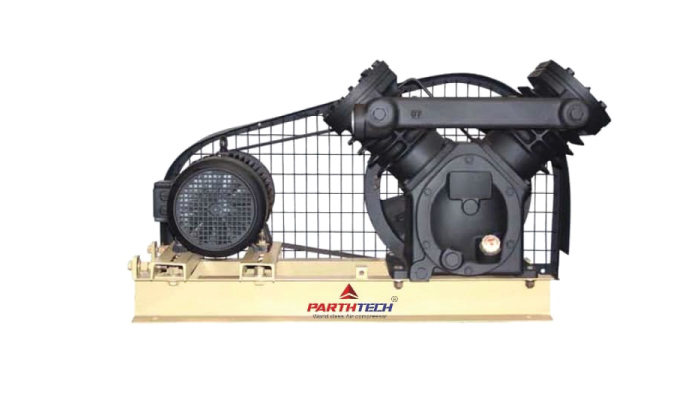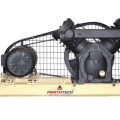-
Call
-
Whatsapp
9825014048
-
Location


Dry Vacuum Pump
Dry Vacuum Pump
Application: Hospitals, Pharmaceutical Industries, Medical.
A vacuum pump is a mechanical device designed to remove air, gas, or other fluids from a closed container or space to create a vacuum or lower pressure environment. It accomplishes this by drawing air or gas out of the container, creating a partial vacuum inside.
Vacuum pumps come in various types, such as rotary vane pumps, diaphragm pumps, and centrifugal pumps, each suited to specific vacuum level requirements and applications.
Dry Vacuum Pump
Historical Overview:
Vacuum pumps have a rich history of development dating back to the 17th century when primitive vacuum techniques were used in scientific experiments. Over time, this device evolved into the sophisticated pumps used today .
Vacuum Pumps:
- Positive Displacement Pumps: This category includes pumps that physically capture and deliver air from the vacuum chamber.
- Rotary vane vacuum: pumps use rotary vanes to compress and move air molecules.
- Diaphragm Vacuum Pump: The diaphragm vibrates to create a vacuum.
- Piston Vacuum Pumps: Pistons move into the cylinder to create a vacuum.
- Momentum transfer pumps: These pumps rely on gas-molecule collisions to release the gas from the vacuum chamber.
- Diffusion vacuum pumps: Diffusion of air molecules.
- Turbomolecular vacuum pump: Rapidly rotating blades capture and deliver air molecules.
- Entrapment Pumps: These pumps trap gas molecules on the surface or inside the object.
- Cryogenic Vacuum Pump: The gas freezes and adheres to surfaces due to the extremely low temperature.
- Lon Pump: Use an electric field to ionize and capture gas molecules.
Vacuum Pump Control
- Industrial Manufacturing: Vacuum pumps are used in various manufacturing processes, such as vacuum packaging, degassing, and material handling.
- Scientific research and laboratories: Laboratories rely on vacuum pumps for analysis, sample processing, and analytical instruments such as mass spectrometers.
- Medical and Health Care: Medical devices such as MRI machines and vacuum-assisted wound closure devices rely on vacuum pumps.
- Electronics and Semiconductor Manufacturing: Vacuum pumps are crucial to creating the clean and controlled environment necessary for semiconductor manufacturing.
- Food packaging and processing: Vacuum sealing extends the shelf life of foods, and vacuum pumps are an essential part of this process.
- HVAC systems: Vacuum pumps remove air and water from HVAC systems, making them more efficient.
- Automotive Industry: Vacuum pumps are used in braking and exhaust systems. This application demonstrates vacuum pumps' versatility and their importance in a variety of industries and situations. Creating and manipulating a controlled environment in the air is essential for many manufacturing processes and technologies.
Choosing the Right Vacuum Pump
Factors such as the amount of vacuum required, gas content, and desired flow rate are considered when selecting the right vacuum pump for a particular application. It is essential to match the pump to the unique requirements of the job at hand.
Repair and Maintenance
Regular maintenance is necessary to ensure the smooth operation and longevity of the vacuum pump. This includes inspection, lubrication, oil changes, and following recommended maintenance schedules.
Advances in Vacuum Pump Technology
Technological advances have led to developing energy-efficient pumps with digital control systems. These innovations align with Industry 4.0 principles, enabling improved automation and communication.
Safety Considerations
Safety is paramount when working with vacuum pumps, especially in engineering and science. Adequate ventilation and the handling of potentially hazardous materials are essential elements of safe operation.
Environmental Impact
The choice of vacuum pump oil can affect the environment. Sustainable practices such as choosing environmentally friendly oils and recycling used oils help reduce the environmental footprint of vacuum pump operations.
Cost Analysis
While the initial investment in a vacuum pump can vary, it's essential to consider long-term savings, including energy efficiency and maintenance costs. Pump type and intended use affect total costs.
Conclusion
Vacuum pumps are everywhere today, supporting businesses, scientific discoveries, and everyday conveniences. Their role in creating and maintaining vacuum zones is essential, and continuous advances in technology continue to expand their applications. As the industry develops and scientific knowledge deepens, vacuum pumps remain a tool essential for monitoring the controlled environment and improving various services.
Features of Dry Vacuum Pump
- Proper Air Removal: Vacuum pumps excel at removing air from closed systems, allowing for precise control of pressure levels. This performance is critical where air removal is essential, such as in construction, laboratories, and HVSC systems.
- A Broad Range of Pressures: Vacuum pumps are available in different sizes, allowing for various pressures. A vacuum pump is capable of providing a high vacuum for scientific research or a low vacuum for industrial applications.
- Miscellaneous: Vacuum pumps come in different types to suit specific applications. Some common types are rotary vane pumps, diaphragm pumps, and turbomolecular pumps. Each type has distinct advantages, such as higher pumping speeds, oil-free operation, or compatibility with strong winds.
- Reliable Performance: Vacuum pumps are known for their reliability. They can be operated continuously, making them ideal for applications that require a continuous vacuum. Their rugged construction allows them to work for long periods.
- Oil-free Options: Oil-free vacuum pumps are available where contaminated oil is a concern. These pumps use techniques like diaphragm or scroll technology to create a vacuum without lubricating oil.
- Silent Operation: Many vacuum pumps are designed to operate quietly, making them suitable for use in laboratories, medical facilities, and other noisy environments.
- Compact and Portable: Portable vacuum pumps are available for applications that require mobility. These small units are easily transported and maintained, making them a valuable tool in fieldwork and on-site handling.
- Energy Efficiency: Energy efficiency is a key consideration when designing modern vacuum pumps. Advanced features, such as variable-speed automatic transmission and intelligent motor control, are often incorporated to deliver energy efficiency while maintaining operational efficiency.
- Easy Maintenance: Vacuum pumps generally have straightforward maintenance requirements. Routine tasks may include changing the oil (for oil-filled pumps), inspecting seals, and cleaning supplies. Regular maintenance of the pump ensures regular operation and extends its life.
- Cheaper Options: Vacuum pumps are available in various price ranges, allowing companies and researchers to find models that fit their budgets without compromising quality.
- Compatibility with Winds: Vacuum pumps can handle various gases, from inert to corrosive and highly reactive. This versatility makes them valuable in industries as diverse as semiconductor manufacturing and chemical engineering.
- Ventilation and Safety Features: Safety is paramount when working with a vacuum pump. Many systems incorporate safety features such as overpressure protection and adequate ventilation to ensure proper operation.
- Environmental Considerations: Some vacuum pumps are designed to operate using environmentally sustainable materials, refrigeration, and eco-friendly materials for a small environmental impact.
- Flexibility: A vacuum pump can be connected to vacuum chambers, gauges, valves and other components to adjust applications.
- Increased Score: Many vacuum pumps have advanced mechanical controls, allowing users to control and adjust components remotely, contributing to efficiency and accuracy.
| Model | Piston Displacement | Max. Pressure | Motor H.P. |
No of Cyl. | ||
| CFM | M 3 / H | MM | Inch | |||
| PT 15/1 SV | 6.78 | 11.49 | 635 | 25 | 1.5 | 1 |
| PT 30 SV | 18 | 30.5 | 736.6 | 29 | 2 | 2 |
| PT 30 TV | 9 | 15.25 | 751.8 | 29.6 | 2 | 2 |
| PT 75 SV | 32 | 54.23 | 753.6 | 29 | 3 | 2 |
| PT 75 TV | 16 | 27.11 | 753.1 | 29.6 | 3 | 2 |
| PT 100 SV | 60 | 101.69 | 736.6 | 29 | 5 | 2 |
| PT 100 TV | 30 | 50.85 | 754.4 | 29.7 | 5 | 2 |
| PT 125 SV | 99 | 167.8 | 736.6 | 29 | 7.5 | 2 |
| PT 125 TV | 49.5 | 83.9 | 753.1 | 29.65 | 7.5 | 2 |
| PT 200 SV | 133 | 225 | 741.7 | 29.2 | 10 | 3 |
| PT 200 TV | 88.6 | 150 | 753.1 | 29.65 | 10 | 3 |


FAQs

Frequently Ask Questions
A vacuum pump is a device that removes air and gases from enclosed spaces to create a vacuum or low pressure atmosphere. It works by absorbing water, forcing air out of the room
Vacuum pumps come in a variety of types, including rotary vane, diaphragm, piston and scroll pumps, each suited to a specific application. Choose one according to your needs and requirements.
The price of a vacuum pump varies greatly depending on the type, size and brand. Small, portable vacuum pumps can cost hundreds of dollars, while larger industrial units can cost thousands or more.
Factors such as intended use, required vacuum levels, pump capacity, and maintenance requirements should be considered when purchasing a vacuum pump. Choosing the right pump for your specific needs is important.
The frequency of oil changes depends on the type and use of the pump. In general, oil-filled pumps may require an oil change every 3,000 to 4,000 operating hours or when the oil appears to be running out or dirty.


